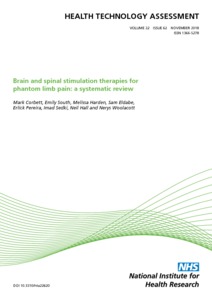Corbett, M; South, E; Harden, M; Eldabe, S; Pereira, E; Sedki, I; Hall, N; Woolacott, N
(2018)
Brain and spinal stimulation therapies for phantom limb pain: a systematic review.
Health Technol Assess, 22 (62).
pp. 1-94.
ISSN 2046-4924
https://doi.org/10.3310/hta22620
SGUL Authors: Pereira, Erlick Abilio Coelho
![[img]](https://openaccess.sgul.ac.uk/110435/1.hassmallThumbnailVersion/3021509.pdf)  Preview |
|
PDF
Published Version
Available under License ["licenses_description_publisher" not defined].
Download (714kB)
| Preview
|
Abstract
BACKGROUND: Although many treatments exist for phantom limb pain (PLP), the evidence supporting them is limited and there are no guidelines for PLP management. Brain and spinal cord neurostimulation therapies are targeted at patients with chronic PLP but have yet to be systematically reviewed. OBJECTIVE: To determine which types of brain and spinal stimulation therapy appear to be the best for treating chronic PLP. DESIGN: Systematic reviews of effectiveness and epidemiology studies, and a survey of NHS practice. POPULATION: All patients with PLP. INTERVENTIONS: Invasive interventions - deep brain stimulation (DBS), motor cortex stimulation (MCS), spinal cord stimulation (SCS) and dorsal root ganglion (DRG) stimulation. Non-invasive interventions - repetitive transcranial magnetic stimulation (rTMS) and transcranial direct current stimulation (tDCS). MAIN OUTCOME MEASURES: Phantom limb pain and quality of life. DATA SOURCES: Twelve databases (including MEDLINE and EMBASE) and clinical trial registries were searched in May 2017, with no date limits applied. REVIEW METHODS: Two reviewers screened titles and abstracts and full texts. Data extraction and quality assessments were undertaken by one reviewer and checked by another. A questionnaire was distributed to clinicians via established e-mail lists of two relevant clinical societies. All results were presented narratively with accompanying tables. RESULTS: Seven randomised controlled trials (RCTs), 30 non-comparative group studies, 18 case reports and 21 epidemiology studies were included. Results from a good-quality RCT suggested short-term benefits of rTMS in reducing PLP, but not in reducing anxiety or depression. Small randomised trials of tDCS suggested the possibility of modest, short-term reductions in PLP. No RCTs of invasive therapies were identified. Results from small, non-comparative group studies suggested that, although many patients benefited from short-term pain reduction, far fewer maintained their benefits. Most studies had important methodological or reporting limitations and few studies reported quality-of-life data. The evidence on prognostic factors for the development of chronic PLP from the longitudinal studies also had important limitations. The results from these studies suggested that pre-amputation pain and early PLP intensity are good predictors of chronic PLP. Results from the cross-sectional studies suggested that the proportion of patients with severe chronic PLP is between around 30% and 40% of the chronic PLP population, and that around one-quarter of chronic PLP patients find their PLP to be either moderately or severely limiting or bothersome. There were 37 responses to the questionnaire distributed to clinicians. SCS and DRG stimulation are frequently used in the NHS but the prevalence of use of DBS and MCS was low. Most responders considered SCS and DRG stimulation to be at least sometimes effective. Neurosurgeons had mixed views on DBS, but most considered MCS to rarely be effective. Most clinicians thought that a randomised trial design could be successfully used to study neurostimulation therapies. LIMITATION: There was a lack of robust research studies. CONCLUSIONS: Currently available studies of the efficacy, effectiveness and safety of neurostimulation treatments do not provide robust, reliable results. Therefore, it is uncertain which treatments are best for chronic PLP. FUTURE WORK: Randomised crossover trials, randomised N-of-1 trials and prospective registry trials are viable study designs for future research. STUDY REGISTRATION: The study is registered as PROSPERO CRD42017065387. FUNDING: The National Institute for Health Research Health Technology Assessment programme.
| Item Type: |
Article
|
| Additional Information: |
© Queen’s Printer and Controller of HMSO 2018. This work was produced by Corbett et al. under the terms of a commissioning contract issued by the Secretary of State for Health and Social Care. This issue may be freely reproduced for the purposes of private research and study and extracts (or indeed, the full report) may be included in professional journals provided that suitable acknowledgement is made and the reproduction is not associated with any form of advertising. Applications for commercial reproduction should be addressed to: NIHR Journals Library, National Institute for Health Research, Evaluation, Trials and Studies Coordinating Centre, Alpha House, University of Southampton Science Park, Southampton SO16 7NS, UK. |
| Keywords: |
1117 Public Health And Health Services, 0807 Library And Information Studies, 0806 Information Systems, Health Policy & Services |
| SGUL Research Institute / Research Centre: |
Academic Structure > Molecular and Clinical Sciences Research Institute (MCS) |
| Journal or Publication Title: |
Health Technol Assess |
| ISSN: |
2046-4924 |
| Language: |
eng |
| Dates: |
| Date | Event |
|---|
| November 2018 | Published | | May 2018 | Accepted |
|
| Publisher License: |
Publisher's own licence |
| Projects: |
|
| PubMed ID: |
30407905 |
| Web of Science ID: |
WOS:000449509600001 |
 |
Go to PubMed abstract |
| URI: |
https://openaccess.sgul.ac.uk/id/eprint/110435 |
| Publisher's version: |
https://doi.org/10.3310/hta22620 |
Statistics
Item downloaded times since 30 Nov 2018.
Actions (login required)
 |
Edit Item |



